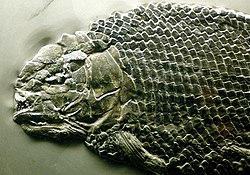Lepidotes
| Lepidotes Temporal range:
| |
|---|---|

| |
| Fossil specimen of L. gigas | |
| Scientific classification | |
| Domain: | Eukaryota |
| Kingdom: | Animalia |
| Phylum: | Chordata |
| Class: | Actinopterygii |
| Clade: | Ginglymodi |
| Order: | Lepisosteiformes |
| Family: | †Lepidotidae |
| Genus: | †Lepidotes Agassiz, 1832[1] |
| Type species | |
| †Lepidotes gigas Agassiz, 1832
| |
| Species[3] | |
| Synonyms[4] | |
|
Genus synonymy Species synonymy
| |
Lepidotes (from Greek: λεπιδωτός lepidōtós, 'covered with scales') (previously known as Lepidotus)[5] is an extinct genus of Mesozoic ray-finned fish. It has long been considered a wastebasket taxon, characterised by "general features, such as thick rhomboid scales and, for most of the species, by semi-tritorial or strongly tritorial dentition".[clarify][6] with dozens of species assigned to it.[4] Fossils attributed to Lepidotes have been found in Jurassic and Cretaceous rocks worldwide.[7][8][9][10] It has been argued that Lepidotes should be restricted to species closely related to the type species L. gigas, which are only known from the Early Jurassic of Western and Central Europe, with most other species being not closely related, with other species transferred to new genera such as Scheenstia.[7] Lepidotes belongs to Ginglymodi, a clade of fish whose only living representatives are the gars (Lepisosteidae). The type species L. gigas and close relatives are thought to be members of the family Lepidotidae, part of the order Lepisosteiformes within Ginglymodi, with other species occupying various other positions within Ginglymodi.[7]
Description

Inhabiting both freshwater lakes and shallow seas, Lepidotes was typically about 30 centimetres (12 in) long. The body was covered with thick, enamelled scales.[11]
Lepidotes was one of the earliest fish in which the upper jawbones were no longer attached to the
Lepidotes scales are ovular in shape, and are 18.5 millimetres (0.73 in) long and 3 millimetres (0.12 in) thick at the thickest point.[12] The scales are smooth and shiny on the external surface, with only a few small depressions scattered toward the centre that are shaped like punctures.[12]
Stomach contents of Lepidotes from the Early Jurassic of Germany have found remains of crustacean
Distinguishing characteristics
Many characteristics were identified by Woodward in 1895, and they are listed below:[4]
- a fusiform trunk only moderately compressed;
- the fact that the marginal teeth are compressed;
- the presence of stouter inner teeth that are smooth;
- ossified ribs;
- very large fin-fulera on all fins;
- that all paired fins are small;
- short and deep dorsal and anal fins;
- very robust, smooth or feebly oriented scales;
- flank scales that are not much deeper than wide;
- scales ventrally nearly as deep as broad;
- and the presence of inconspicuous dorsal and ventral ridge-scales.
Taxonomy
Currently valid species after.[7]
L. gigas
The type species of the genus, it is known from the Early Jurassic (Toarcian) of Germany.[7]
L. elvensis
L. elvensis was described by
L. semiserratus
This species was named by Agassiz in 1837 and is known from some incomplete remains. It has been classified as closely related to L. elvensis. It is more elongate than L. elvensis, being four times as long as tall. It also has more sharply angulated sutures between its parietals, and the parietals are also proportionally longer. It is known from the specimens P. 1127, P. 7409, P. 2012, P. 2012a, P. 3527, P. 3528, P. 3528a, P. 5213, P. 5228, P. 6394, P. 7410, and 35556, all from the Upper Lias of Yorkshire, England[4]
L. buelowianus
Known from the Early Jurassic of (Toarcian) Germany.[7]
Reassigned species
"Lepidotes" latifrons from the Middle-Late Jurassic of England has been reassigned to the genus Isanichthys.[14] Many other European species from the Late Jurassic-Early Cretaceous have been reassigned to Scheenstia.[7]
References
- ^ Agassiz, L. (1832), Untersuchungen über die fossilen Fische der Lias-Formation. Jahrbuch für Mineralogie, Geognosie, Geologie und Petrefaktenkunde 3: 145
- ^ Lepidotes buelowianus
- ^ )
- ^ Hunterian Museum Geology Collections. "Lepidotes" Archived 2017-03-12 at the Wayback Machine.
- S2CID 199631685.
- ^ PMID 22808031.
- ^ John G. Maisey, Discovering Fossil Fishes, 1996:150, 152.
- .
- S2CID 130069487.
- ^ ISBN 1-84028-152-9.
- ^ a b Lambe, L.M. (1902). "New Genera and Species from the Belly River Series (mid cretaceous)". Geological Survey of Canada. Contributions to Canadian Palaeontology. 3: 25–81.
- S2CID 203892069.
- .
